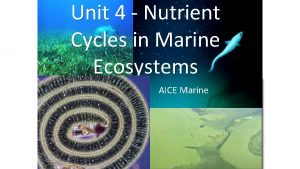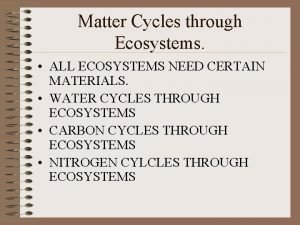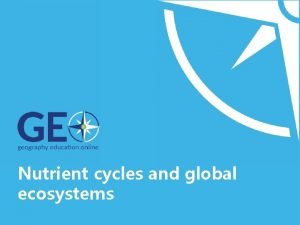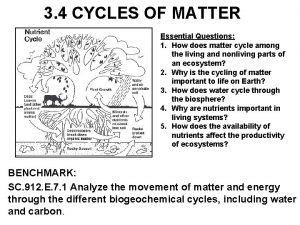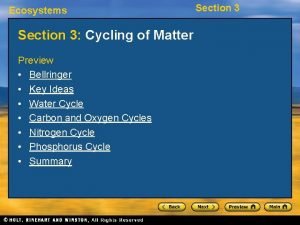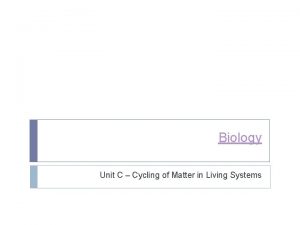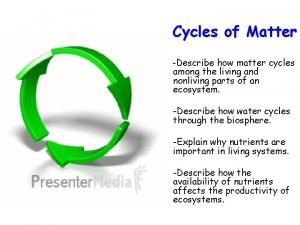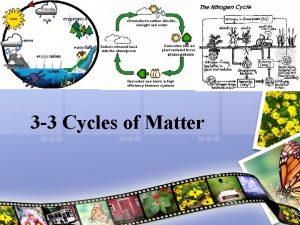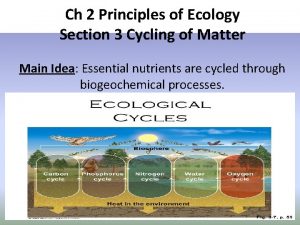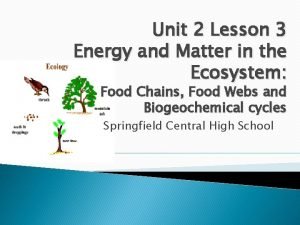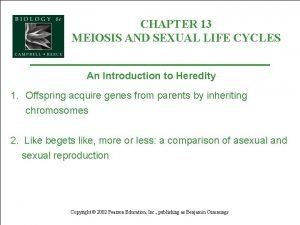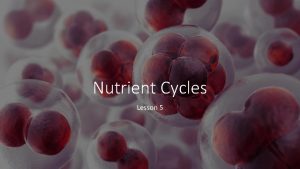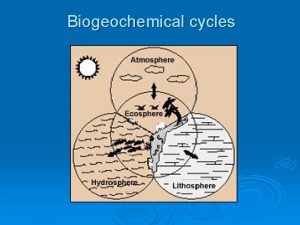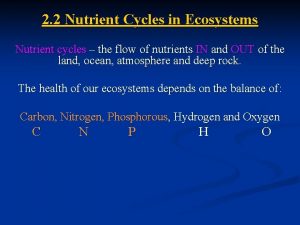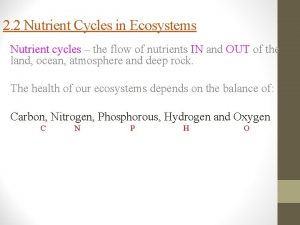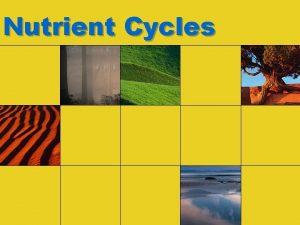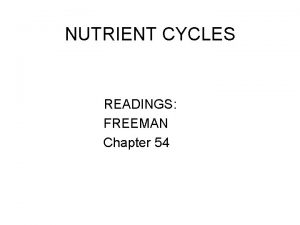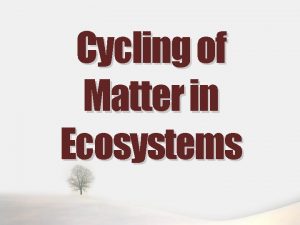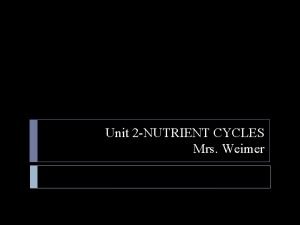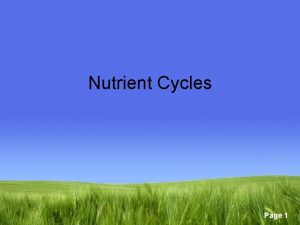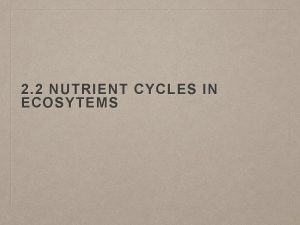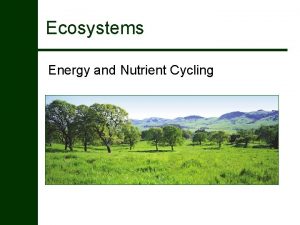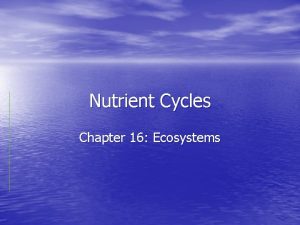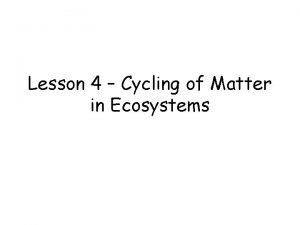Chapter 3 Nutrient Cycles MATTER CYCLING IN ECOSYSTEMS


















- Slides: 18

Chapter 3 Nutrient Cycles

MATTER CYCLING IN ECOSYSTEMS Ø Nutrient Cycles: Global Recycling l l l Global Cycles recycle nutrients through the earth’s air, land, water, and living organisms. Nutrients are the elements and compounds that organisms need to live, grow, and reproduce. Biogeochemical cycles move these substances through air, water, soil, rock and living organisms.

Water’ Unique Properties Ø There are strong forces of attraction between molecules of water. Ø Water exists as a liquid over a wide temperature range. Ø Liquid water changes temperature slowly. Ø It takes a large amount of energy for water to evaporate. Ø Liquid water can dissolve a variety of compounds. Ø Water expands when it freezes.

The Water Cycle Figure 3 -26

Effects of Human Activities on Water Cycle Ø We alter the water cycle by: l l Withdrawing large amounts of freshwater. Clearing vegetation and eroding soils. Polluting surface and underground water. Contributing to climate change.

The Carbon Cycle: Part of Nature’s Thermostat Figure 3 -27

Effects of Human Activities on Carbon Cycle Ø We alter the carbon cycle by adding excess CO 2 to the atmosphere through: l l Burning fossil fuels. Clearing vegetation faster than it is replaced. Figure 3 -28

The Nitrogen Cycle: Bacteria in Action Figure 3 -29

Nitrogen Cycling Terminology Ø Fixing Nitrogen- converting nitrogen gas into forms that can be used by plants *electrical discharge *nitrogen fixing bacteria Nitrogen Fixation– soil Bac. T, produce ammonium

Ø Nitrification– soil Bac. T, produces nitrate

Ø Ammonification- decomposing Bac. T convert wastes, dead organisms. Produces ammonia and ammonium

Ø Denitrification-water Bac. T

Effects of Human Activities on the Nitrogen Cycle Ø We alter the nitrogen cycle by: l l Adding gases that contribute to acid rain. Adding nitrous oxide to the atmosphere through farming practices which can warm the atmosphere and deplete ozone. Contaminating ground water from nitrate ions in inorganic fertilizers. Releasing nitrogen into the troposphere through deforestation.

Effects of Human Activities on the Nitrogen Cycle Ø Human activities such as production of fertilizers now fix more nitrogen than all natural sources combined. Figure 3 -30

The Phosphorous Cycle Figure 3 -31

Effects of Human Activities on the Phosphorous Cycle Ø We remove large amounts of phosphate from the earth to make fertilizer. Ø We reduce phosphorous in tropical soils by clearing forests. Ø We add excess phosphates to aquatic systems from runoff of animal wastes and fertilizers.

The Sulfur Cycle Figure 3 -32

Effects of Human Activities on the Sulfur Cycle Ø We add sulfur dioxide to the atmosphere by: l l l Burning coal and oil Refining sulfur containing petroleum. Convert sulfur-containing metallic ores into free metals such as copper, lead, and zinc releasing sulfur dioxide into the environment.
 A terrestrial food web
A terrestrial food web Matter cycling in ecosystems
Matter cycling in ecosystems Uses of selenite f broth
Uses of selenite f broth Apes nutrient cycles
Apes nutrient cycles Gersmehl cycle
Gersmehl cycle Principles of ecology chapter 2
Principles of ecology chapter 2 4 cycles of life
4 cycles of life Section 3 cycling of matter
Section 3 cycling of matter Section 1 organisms and their relationships
Section 1 organisms and their relationships Section 1 organisms and their relationships
Section 1 organisms and their relationships Cycling of matter definition biology
Cycling of matter definition biology Water cycles of matter
Water cycles of matter 3-3 cycles of matter
3-3 cycles of matter Lesson 2 cycles of matter answer key
Lesson 2 cycles of matter answer key Lesson 3 energy and matter in ecosystems answer key
Lesson 3 energy and matter in ecosystems answer key Chapter 2 section 1 classifying matter answers
Chapter 2 section 1 classifying matter answers Chapter 13: meiosis and sexual life cycles
Chapter 13: meiosis and sexual life cycles Chapter 13 meiosis and sexual life cycles
Chapter 13 meiosis and sexual life cycles Chapter 3 section 3 aquatic ecosystems
Chapter 3 section 3 aquatic ecosystems
